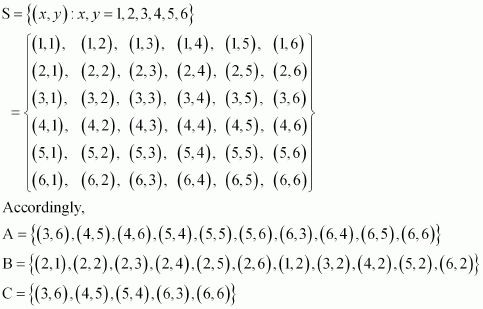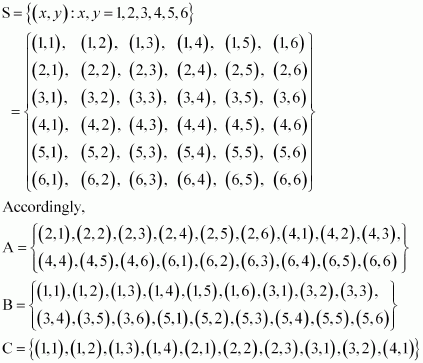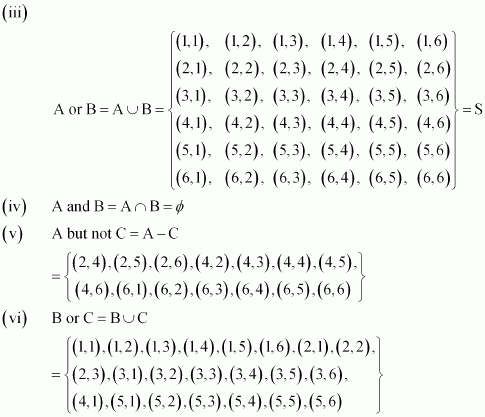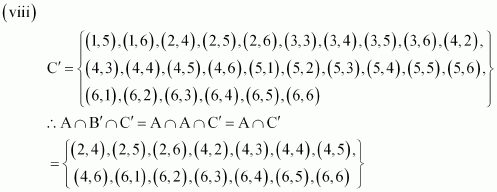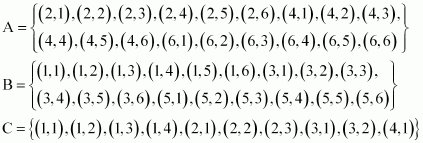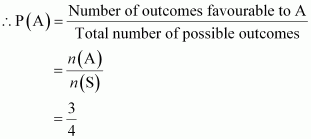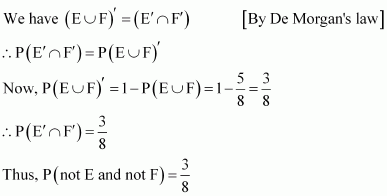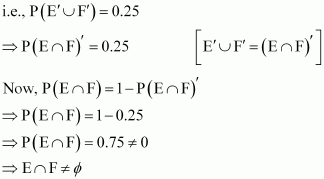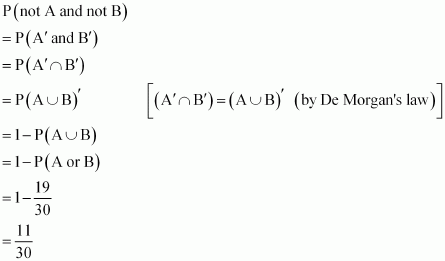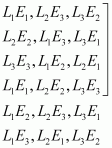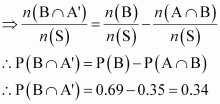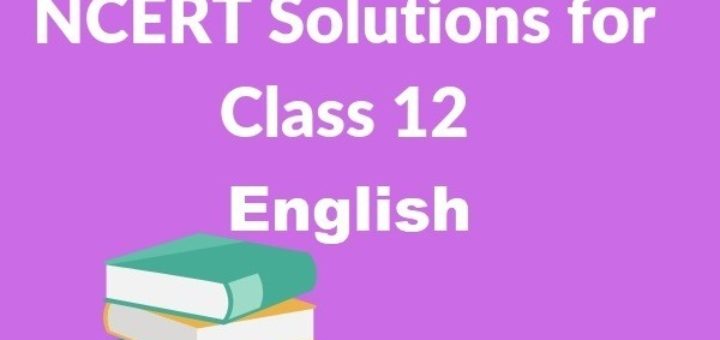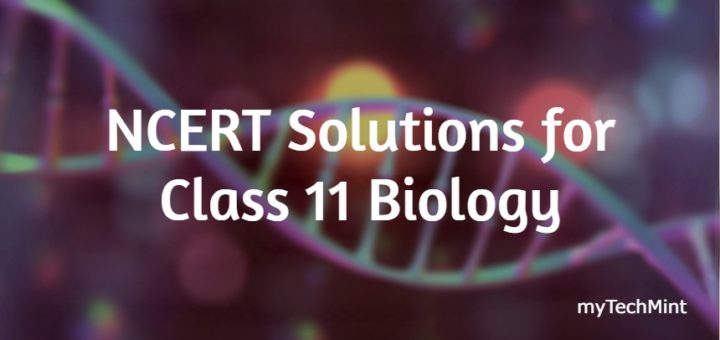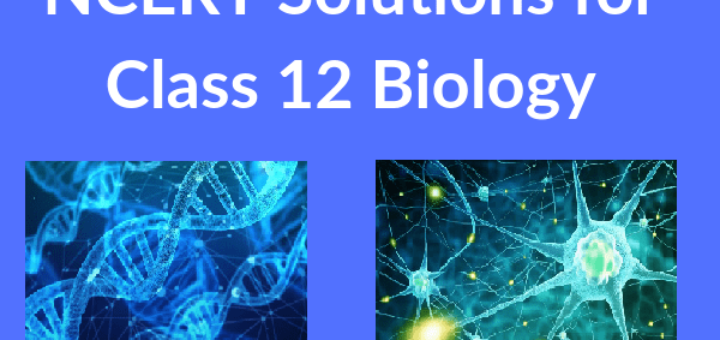NCERT Solutions for Class 11 Maths Chapter 16 – Probability
Page No 386:
Question 1:
Describe the sample space for the indicated experiment: A coin is tossed three times.
ANSWER:
A coin has two faces: head (H) and tail (T).
When a coin is tossed three times, the total number of possible outcomes is 23 = 8
Thus, when a coin is tossed three times, the sample space is given by:
S = {HHH, HHT, HTH, HTT, THH, THT, TTH, TTT}
Page No 386:
Question 2:
Describe the sample space for the indicated experiment: A die is thrown two times.
ANSWER:
When a die is thrown, the possible outcomes are 1, 2, 3, 4, 5, or 6.
When a die is thrown two times, the sample space is given by S = {(x, y): x, y = 1, 2, 3, 4, 5, 6}
The number of elements in this sample space is 6 × 6 = 36, while the sample space is given by:
S = {(1, 1), (1, 2), (1, 3), (1, 4), (1, 5), (1, 6), (2, 1), (2, 2), (2, 3), (2, 4), (2, 5), (2, 6), (3, 1), (3, 2), (3, 3), (3, 4), (3, 5), (3, 6), (4, 1), (4, 2), (4, 3), (4, 4), (4, 5), (4, 6), (5, 1), (5, 2), (5, 3), (5, 4), (5, 5), (5, 6), (6, 1), (6, 2), (6, 3), (6, 4), (6, 5), (6, 6)}
Page No 386:
Question 3:
Describe the sample space for the indicated experiment: A coin is tossed four times.
ANSWER:
When a coin is tossed once, there are two possible outcomes: head (H) and tail (T).
When a coin is tossed four times, the total number of possible outcomes is 24 = 16
Thus, when a coin is tossed four times, the sample space is given by:
S = {HHHH, HHHT, HHTH, HHTT, HTHH, HTHT, HTTH, HTTT, THHH, THHT, THTH, THTT, TTHH, TTHT, TTTH, TTTT}
Page No 386:
Question 4:
Describe the sample space for the indicated experiment: A coin is tossed and a die is thrown.
ANSWER:
A coin has two faces: head (H) and tail (T).
A die has six faces that are numbered from 1 to 6, with one number on each face.
Thus, when a coin is tossed and a die is thrown, the sample space is given by:
S = {H1, H2, H3, H4, H5, H6, T1, T2, T3, T4, T5, T6}
Page No 386:
Question 5:
Describe the sample space for the indicated experiment: A coin is tossed and then a die is rolled only in case a head is shown on the coin.
ANSWER:
A coin has two faces: head (H) and tail (T).
A die has six faces that are numbered from 1 to 6, with one number on each face.
Thus, when a coin is tossed and then a die is rolled only in case a head is shown on the coin, the sample space is given by:
S = {H1, H2, H3, H4, H5, H6, T}
Page No 386:
Question 6:
2 boys and 2 girls are in Room X, and 1 boy and 3 girls in Room Y. Specify the sample space for the experiment in which a room is selected and then a person.
ANSWER:
Let us denote 2 boys and 2 girls in room X as B1, B2 and G1, G2 respectively. Let us denote 1 boy and 3 girls in room Y as B3, and G3, G4, G5 respectively.
Accordingly, the required sample space is given by S = {XB1, XB2, XG1, XG2, YB3, YG3, YG4, YG5}
Page No 386:
Question 7:
One die of red colour, one of white colour and one of blue colour are placed in a bag. One die is selected at random and rolled, its colour and the number on its uppermost face is noted. Describe the sample space.
ANSWER:
A die has six faces that are numbered from 1 to 6, with one number on each face.
Let us denote the red, white, and blue dices as R, W, and B respectively.
Accordingly, when a die is selected and then rolled, the sample space is given by
S = {R1, R2, R3, R4, R5, R6, W1, W2, W3, W4, W5, W6, B1, B2, B3, B4, B5, B6}
Page No 386:
Question 8:
An experiment consists of recording boy-girl composition of families with 2 children.
(i) What is the sample space if we are interested in knowing whether it is a boy or girl in the order of their births?
(ii) What is the sample space if we are interested in the number of girls in the family?
ANSWER:
(i) When the order of the birth of a girl or a boy is considered, the sample space is given by S = {GG, GB, BG, BB}
(ii) Since the maximum number of children in each family is 2, a family can either have 2 girls or 1 girl or no girl. Hence, the required sample space is S = {0, 1, 2}
Page No 387:
Question 9:
A box contains 1 red and 3 identical white balls. Two balls are drawn at random in succession without replacement. Write the sample space for this experiment.
ANSWER:
It is given that the box contains 1 red ball and 3 identical white balls. Let us denote the red ball with R and a white ball with W.
When two balls are drawn at random in succession without replacement, the sample space is given by
S = {RW, WR, WW}
Page No 387:
Question 10:
An experiment consists of tossing a coin and then throwing it second time if a head occurs. If a tail occurs on the first toss, then a die is rolled once. Find the sample space.
ANSWER:
A coin has two faces: head (H) and tail (T).
A die has six faces that are numbered from 1 to 6, with one number on each face.
Thus, in the given experiment, the sample space is given by
S = {HH, HT, T1, T2, T3, T4, T5, T6}
Page No 387:
Question 11:
Suppose 3 bulbs are selected at random from a lot. Each bulb is tested and classified as defective (D) or non-defective (N). Write the sample space of this experiment?
ANSWER:
3 bulbs are to be selected at random from the lot. Each bulb in the lot is tested and classified as defective (D) or non-defective (N).
The sample space of this experiment is given by
S = {DDD, DDN, DND, DNN, NDD, NDN, NND, NNN}
Page No 387:
Question 12:
A coin is tossed. If the out come is a head, a die is thrown. If the die shows up an even number, the die is thrown again. What is the sample space for the experiment?
ANSWER:
When a coin is tossed, the possible outcomes are head (H) and tail (T).
When a die is thrown, the possible outcomes are 1, 2, 3, 4, 5, or 6.
Thus, the sample space of this experiment is given by:
S = {T, H1, H3, H5, H21, H22, H23, H24, H25, H26, H41, H42, H43, H44, H45, H46, H61, H62, H63, H64, H65, H66}
Page No 387:
Question 13:
The numbers 1, 2, 3 and 4 are written separately on four slips of paper. The slips are put in a box and mixed thoroughly. A person draws two slips from the box, one after the other, without replacement. Describe the sample space for the experiment.
ANSWER:
If 1 appears on the first drawn slip, then the possibilities that the number appears on the second drawn slip are 2, 3, or 4. Similarly, if 2 appears on the first drawn slip, then the possibilities that the number appears on the second drawn slip are 1, 3, or 4. The same holds true for the remaining numbers too.
Thus, the sample space of this experiment is given by S = {(1, 2), (1, 3), (1, 4), (2, 1), (2, 3), (2, 4), (3, 1), (3, 2), (3, 4), (4, 1), (4, 2), (4, 3)}
Page No 387:
Question 14:
An experiment consists of rolling a die and then tossing a coin once if the number on the die is even. If the number on the die is odd, the coin is tossed twice. Write the sample space for this experiment.
ANSWER:
A die has six faces that are numbered from 1 to 6, with one number on each face. Among these numbers, 2, 4, and 6 are even numbers, while 1, 3, and 5 are odd numbers.
A coin has two faces: head (H) and tail (T).
Hence, the sample space of this experiment is given by:
S = {2H, 2T, 4H, 4T, 6H, 6T, 1HH, 1HT, 1TH, 1TT, 3HH, 3HT, 3TH, 3TT, 5HH, 5HT, 5TH, 5TT}
Page No 387:
Question 15:
A coin is tossed. If it shows a tail, we draw a ball from a box which contains 2 red and 3 black balls. If it shows head, we throw a die. Find the sample space for this experiment.
ANSWER:
The box contains 2 red balls and 3 black balls. Let us denote the 2 red balls as R1, R2 and the 3 black balls as B1, B2, and B3.
The sample space of this experiment is given by
S = {TR1, TR2, TB1, TB2, TB3, H1, H2, H3, H4, H5, H6}
Page No 387:
Question 16:
A die is thrown repeatedly until a six comes up. What is the sample space for this experiment?
ANSWER:
In this experiment, six may come up on the first throw, the second throw, the third throw and so on till six is obtained.
Hence, the sample space of this experiment is given by
S = {6, (1, 6), (2, 6), (3, 6), (4, 6), (5, 6), (1, 1, 6), (1, 2, 6), … , (1, 5, 6), (2, 1, 6), (2, 2, 6), … , (2, 5, 6), … ,(5, 1, 6), (5, 2, 6), …}
Page No 393:
Question 1:
A die is rolled. Let E be the event “die shows 4” and F be the event “die shows even number”. Are E and F mutually exclusive?
ANSWER:
When a die is rolled, the sample space is given by
S = {1, 2, 3, 4, 5, 6}
Accordingly, E = {4} and F = {2, 4, 6}
It is observed that E ∩ F = {4} ≠ Φ
Therefore, E and F are not mutually exclusive events.
Page No 393:
Question 2:
A die is thrown. Describe the following events:
(i) A: a number less than 7 (ii) B: a number greater than 7 (iii) C: a multiple of 3
(iv) D: a number less than 4 (v) E: an even number greater than 4 (vi) F: a number not less than 3
Also find
ANSWER:
When a die is thrown, the sample space is given by S = {1, 2, 3, 4, 5, 6}.
Accordingly:
(i) A = {1, 2, 3, 4, 5, 6}
(ii) B = Φ
(iii) C = {3, 6}
(iv) D = {1, 2, 3}
(v) E = {6}
(vi) F = {3, 4, 5, 6}
A ∪ B = {1, 2, 3, 4, 5, 6}, A ∩ B = Φ
B ∪ C = {3, 6}, E ∩ F = {6}
D ∩ E =Φ, A – C = {1, 2, 4, 5}
D – E = {1, 2, 3},
Page No 393:
Question 3:
An experiment involves rolling a pair of dice and recording the numbers that come up. Describe the following events:
A: the sum is greater than 8, B: 2 occurs on either die
C: The sum is at least 7 and a multiple of 3.
Which pairs of these events are mutually exclusive?
ANSWER:
When a pair of dice is rolled, the sample space is given by
It is observed that
A ∩ B =Φ
B ∩ C =Φ
Hence, events A and B and events B and C are mutually exclusive.
Page No 393:
Question 4:
Three coins are tossed once. Let A denote the event ‘three heads show”, B denote the event “two heads and one tail show”. C denote the event “three tails show” and D denote the event ‘a head shows on the first coin”. Which events are
(i) mutually exclusive? (ii) simple? (iii) compound?
ANSWER:
When three coins are tossed, the sample space is given by
S = {HHH, HHT, HTH, HTT, THH, THT, TTH, TTT}
Accordingly,
A = {HHH}
B = {HHT, HTH, THH}
C = {TTT}
D = {HHH, HHT, HTH, HTT}
We now observe that
A ∩ B =Φ, A ∩ C =Φ, A ∩ D = {HHH} ≠ Φ
B ∩ C =Φ, B ∩ D = {HHT, {HTH} ≠ Φ
C ∩ D = Φ
(i) Event A and B; event A and C; event B and C; and event C and D are all mutually exclusive.
(ii) If an event has only one sample point of a sample space, it is called a simple event. Thus, A and C are simple events.
(iii) If an event has more than one sample point of a sample space, it is called a compound event. Thus, B and D are compound events.
Page No 393:
Question 5:
Three coins are tossed. Describe
(i) Two events which are mutually exclusive.
(ii) Three events which are mutually exclusive and exhaustive.
(iii) Two events, which are not mutually exclusive.
(iv) Two events which are mutually exclusive but not exhaustive.
(v) Three events which are mutually exclusive but not exhaustive.
ANSWER:
When three coins are tossed, the sample space is given by
S = {HHH, HHT, HTH, HTT, THH, THT, TTH, TTT}
(i) Two events that are mutually exclusive can be
A: getting no heads and B: getting no tails
This is because sets A = {TTT} and B = {HHH} are disjoint.
(ii) Three events that are mutually exclusive and exhaustive can be
A: getting no heads
B: getting exactly one head
C: getting at least two heads
i.e.,
A = {TTT}
B = {HTT, THT, TTH}
C = {HHH, HHT, HTH, THH}
This is because A ∩ B = B ∩ C = C ∩ A = Φand A ∪ B ∪ C = S
(iii) Two events that are not mutually exclusive can be
A: getting three heads
B: getting at least 2 heads
i.e.,
A = {HHH}
B = {HHH, HHT, HTH, THH}
This is because A ∩ B = {HHH} ≠ Φ
(iv) Two events which are mutually exclusive but not exhaustive can be
A: getting exactly one head
B: getting exactly one tail
That is
A = {HTT, THT, TTH}
B = {HHT, HTH, THH}
It is because, A ∩ B =Φ, but A ∪ B ≠ S
(v) Three events that are mutually exclusive but not exhaustive can be
A: getting exactly three heads
B: getting one head and two tails
C: getting one tail and two heads
i.e.,
A = {HHH}
B = {HTT, THT, TTH}
C = {HHT, HTH, THH}
This is because A ∩ B = B ∩ C = C ∩ A = Φ, but A ∪ B ∪ C ≠ S
Page No 393:
Question 6:
Two dice are thrown. The events A, B and C are as follows:
A: getting an even number on the first die.
B: getting an odd number on the first die.
C: getting the sum of the numbers on the dice ≤ 5
Describe the events
(i) (ii) not B (iii) A or B
(iv) A and B (v) A but not C (vi) B or C
(vii) B and C (viii)
ANSWER:
When two dice are thrown, the sample space is given by
(vii) B and C = B ∩ C
Page No 393:
Question 7:
Two dice are thrown. The events A, B and C are as follows:
A: getting an even number on the first die.
B: getting an odd number on the first die.
C: getting the sum of the numbers on the dice ≤ 5
State true or false: (give reason for your answer)
(i) A and B are mutually exclusive
(ii) A and B are mutually exclusive and exhaustive
(iii)
(iv) A and C are mutually exclusive
(v) A and are mutually exclusive
(vi) are mutually exclusive and exhaustive.
ANSWER:
(i) It is observed that A ∩ B = Φ
∴ A and B are mutually exclusive.
Thus, the given statement is true.
(ii) It is observed that A ∩ B = Φ and A ∪ B = S
∴ A and B are mutually exclusive and exhaustive.
Thus, the given statement is true.
(iii) It is observed that
Thus, the given statement is true.
(iv) It is observed that A ∩ C = {(2, 1), (2, 2), (2, 3), (4, 1)} ≠Φ
∴A and C are not mutually exclusive.
Thus, the given statement is false.
(v)
∴A and are not mutually exclusive.
Thus, the given statement is false.
(vi) It is observed that;
However,
Therefore, events are not mutually exclusive and exhaustive.
Thus, the given statement is false.
Page No 403:
Question 1:
Which of the following can not be valid assignment of probabilities for outcomes of sample space S =
| Assignment | ω1 | ω2 | ω3 | ω4 | ω5 | ω6 | ω7 |
| (a) | 0.1 | 0.01 | 0.05 | 0.03 | 0.01 | 0.2 | 0.6 |
| (b) | | | | | | | |
| (c) | 0.1 | 0.2 | 0.3 | 0.4 | 0.5 | 0.6 | 0.7 |
| (d) | –0.1 | 0.2 | 0.3 | 0.4 | –0.2 | 0.1 | 0.3 |
| (e) | | | | | | | |
ANSWER:
(a)
-
ω1
ω2
ω3
ω4
ω5
ω6
ω7
0.1
0.01
0.05
0.03
0.01
0.2
0.6
Here, each of the numbers p(ωi) is positive and less than 1.
Sum of probabilities
Thus, the assignment is valid.
(b)
-
ω1
ω2
ω3
ω4
ω5
ω6
ω7
Here, each of the numbers p(ωi) is positive and less than 1.
Sum of probabilities
Thus, the assignment is valid.
(c)
-
ω1
ω2
ω3
ω4
ω5
ω6
ω7
0.1
0.2
0.3
0.4
0.5
0.6
0.7
Here, each of the numbers p(ωi) is positive and less than 1.
Sum of probabilities
Thus, the assignment is not valid.
(d)
-
ω1
ω2
ω3
ω4
ω5
ω6
ω7
–0.1
0.2
0.3
0.4
–0.2
0.1
0.3
Here, p(ω1) and p(ω5) are negative.
Hence, the assignment is not valid.
(e)
-
ω1
ω2
ω3
ω4
ω5
ω6
ω7
Here,
Hence, the assignment is not valid.
Page No 404:
Question 2:
A coin is tossed twice, what is the probability that at least one tail occurs?
ANSWER:
When a coin is tossed twice, the sample space is given by
S = {HH, HT, TH, TT}
Let A be the event of the occurrence of at least one tail.
Accordingly, A = {HT, TH, TT}
Page No 404:
Question 3:
A die is thrown, find the probability of following events:
(i) A prime number will appear,
(ii) A number greater than or equal to 3 will appear,
(iii) A number less than or equal to one will appear,
(iv) A number more than 6 will appear,
(v) A number less than 6 will appear.
ANSWER:
The sample space of the given experiment is given by
S = {1, 2, 3, 4, 5, 6}
(i) Let A be the event of the occurrence of a prime number.
Accordingly, A = {2, 3, 5}
(ii) Let B be the event of the occurrence of a number greater than or equal to 3. Accordingly, B = {3, 4, 5, 6}
(iii) Let C be the event of the occurrence of a number less than or equal to one. Accordingly, C = {1}
(iv) Let D be the event of the occurrence of a number greater than 6.
Accordingly, D = Φ
(v) Let E be the event of the occurrence of a number less than 6.
Accordingly, E = {1, 2, 3, 4, 5}
Page No 404:
Question 4:
A card is selected from a pack of 52 cards.
(a) How many points are there in the sample space?
(b) Calculate the probability that the card is an ace of spades.
(c) Calculate the probability that the card is (i) an ace (ii) black card.
ANSWER:
(a) When a card is selected from a pack of 52 cards, the number of possible outcomes is 52 i.e., the sample space contains 52 elements.
Therefore, there are 52 points in the sample space.
(b) Let A be the event in which the card drawn is an ace of spades.
Accordingly, n(A) = 1
(c) (i)Let E be the event in which the card drawn is an ace.
Since there are 4 aces in a pack of 52 cards, n(E) = 4
(ii)Let F be the event in which the card drawn is black.
Since there are 26 black cards in a pack of 52 cards, n(F) = 26
Page No 404:
Question 5:
A fair coin with 1 marked on one face and 6 on the other and a fair die are both tossed. Find the probability that the sum of numbers that turn up is (i) 3 (ii) 12
ANSWER:
Since the fair coin has 1 marked on one face and 6 on the other, and the die has six faces that are numbered 1, 2, 3, 4, 5, and 6, the sample space is given by
S = {(1, 1), (1, 2), (1, 3), (1, 4), (1, 5), (1, 6), (6, 1), (6, 2), (6, 3), (6, 4), (6, 5), (6, 6)}
Accordingly, n(S) = 12
(i) Let A be the event in which the sum of numbers that turn up is 3.
Accordingly, A = {(1, 2)}
(ii) Let B be the event in which the sum of numbers that turn up is 12.
Accordingly, B = {(6, 6)}
Page No 404:
Question 6:
There are four men and six women on the city council. If one council member is selected for a committee at random, how likely is it that it is a woman?
ANSWER:
There are four men and six women on the city council.
As one council member is to be selected for a committee at random, the sample space contains 10 (4 + 6) elements.
Let A be the event in which the selected council member is a woman.
Accordingly, n(A) = 6
Page No 404:
Question 7:
A fair coin is tossed four times, and a person win Re 1 for each head and lose Rs 1.50 for each tail that turns up. From the sample space calculate how many different amounts of money you can have after four tosses and the probability of having each of these amounts.
ANSWER:
Since the coin is tossed four times, there can be a maximum of 4 heads or tails.
When 4 heads turns up, is the gain.
When 3 heads and 1 tail turn up, Re 1 + Re 1 + Re 1 – Rs 1.50 = Rs 3 – Rs 1.50 = Rs 1.50 is the gain.
When 2 heads and 2 tails turns up, Re 1 + Re 1 – Rs 1.50 – Rs 1.50 = – Re 1, i.e., Re 1 is the loss.
When 1 head and 3 tails turn up, Re 1 – Rs 1.50 – Rs 1.50 – Rs 1.50 = – Rs 3.50, i.e., Rs 3.50 is the loss.
When 4 tails turn up, – Rs 1.50 – Rs 1.50 – Rs 1.50 – Rs 1.50 = – Rs 6.00, i.e., Rs 6.00 is the loss.
There are 24 = 16 elements in the sample space S, which is given by:
S = {HHHH, HHHT, HHTH, HTHH, THHH, HHTT, HTTH, TTHH, HTHT, THTH, THHT, HTTT, THTT, TTHT, TTTH, TTTT}
∴n(S) = 16
The person wins Rs 4.00 when 4 heads turn up, i.e., when the event {HHHH} occurs.
∴Probability (of winning Rs 4.00) =
The person wins Rs 1.50 when 3 heads and one tail turn up, i.e., when the event {HHHT, HHTH, HTHH, THHH} occurs.
∴Probability (of winning Rs 1.50) =
The person loses Re 1.00 when 2 heads and 2 tails turn up, i.e., when the event {HHTT, HTTH, TTHH, HTHT, THTH, THHT} occurs.
∴Probability (of losing Re 1.00)
The person loses Rs 3.50 when 1 head and 3 tails turn up, i.e., when the event {HTTT, THTT, TTHT, TTTH} occurs.
Probability (of losing Rs 3.50) =
The person loses Rs 6.00 when 4 tails turn up, i.e., when the event {TTTT} occurs.
Probability (of losing Rs 6.00) =
Page No 404:
Question 8:
Three coins are tossed once. Find the probability of getting
(i) 3 heads (ii) 2 heads (iii) at least 2 heads
(iv) at most 2 heads (v) no head (vi) 3 tails
(vii) exactly two tails (viii) no tail (ix) at most two tails.
ANSWER:
When three coins are tossed once, the sample space is given by
S = {HHH, HHT, HTH, THH, HTT, THT, TTH, TTT}
∴Accordingly, n(S) = 8
It is known that the probability of an event A is given by
(i) Let B be the event of the occurrence of 3 heads. Accordingly, B = {HHH}
∴P(B) =
(ii) Let C be the event of the occurrence of 2 heads. Accordingly, C = {HHT, HTH, THH}
∴P(C) =
(iii) Let D be the event of the occurrence of at least 2 heads.
Accordingly, D = {HHH, HHT, HTH, THH}
∴P(D) =
(iv) Let E be the event of the occurrence of at most 2 heads.
Accordingly, E = {HHT, HTH, THH, HTT, THT, TTH, TTT}
∴P(E) =
(v) Let F be the event of the occurrence of no head.
Accordingly, F = {TTT}
∴P(F) =
(vi) Let G be the event of the occurrence of 3 tails.
Accordingly, G = {TTT}
∴P(G) =
(vii) Let H be the event of the occurrence of exactly 2 tails.
Accordingly, H = {HTT, THT, TTH}
∴P(H) =
(viii) Let I be the event of the occurrence of no tail.
Accordingly, I = {HHH}
∴P(I) =
(ix) Let J be the event of the occurrence of at most 2 tails.
Accordingly, I = {HHH, HHT, HTH, THH, HTT, THT, TTH}
∴P(J) =
Page No 404:
Question 9:
Ifis the probability of an event, what is the probability of the event ‘not A’.
ANSWER:
It is given that P(A) =.
Accordingly, P(not A) = 1 – P(A)
Page No 404:
Question 10:
A letter is chosen at random from the word ‘ASSASSINATION’. Find the probability that letter is (i) a vowel (ii) an consonant
ANSWER:
There are 13 letters in the word ASSASSINATION.
∴Hence, n(S) = 13
(i) There are 6 vowels in the given word.
∴Probability (vowel) =
(ii) There are 7 consonants in the given word.
∴Probability (consonant) =
Page No 405:
Question 11:
In a lottery, person choses six different natural numbers at random from 1 to 20, and if these six numbers match with the six numbers already fixed by the lottery committee, he wins the prize. What is the probability of winning the prize in the game? [Hint: order of the numbers is not important.]
ANSWER:
Total number of ways in which one can choose six different numbers from 1 to 20
Hence, there are 38760 combinations of 6 numbers.
Out of these combinations, one combination is already fixed by the lottery committee.
∴ Required probability of winning the prize in the game =
Page No 405:
Question 12:
Check whether the following probabilities P(A) and P(B) are consistently defined
(i) P(A) = 0.5, P(B) = 0.7, P(A ∩ B) = 0.6
(ii) P(A) = 0.5, P(B) = 0.4, P(A ∪ B) = 0.8
ANSWER:
(i) P(A) = 0.5, P(B) = 0.7, P(A ∩ B) = 0.6
It is known that if E and F are two events such that E ⊂ F, then P(E) ≤ P(F).
However, here, P(A ∩ B) > P(A).
Hence, P(A) and P(B) are not consistently defined.
(ii)P(A) = 0.5, P(B) = 0.4, P(A ∪ B) = 0.8
It is known that if E and F are two events such that E ⊂ F, then P(E) ≤ P(F).
Here, it is seen that P(A ∪ B) > P(A) and P(A ∪ B) > P(B).
Hence, P(A) and P(B) are consistently defined.
Page No 405:
Question 13:
Fill in the blanks in following table:
| P(A) | P(B) | P(A ∩ B) | P(A ∪ B) | |
| (i) | | | | … |
| (ii) | 0.35 | … | 0.25 | 0.6 |
| (iii) | 0.5 | 0.35 | … | 0.7 |
ANSWER:
(i) Here,
We know that
(ii) Here, P(A) = 0.35, P(A ∩ B) = 0.25, P(A ∪ B) = 0.6
We know that P(A ∪ B) = P(A) + P(B) – P(A ∩ B)
∴0.6 = 0.35 + P(B) – 0.25
⇒ P(B) = 0.6 – 0.35 + 0.25
⇒ P(B) = 0.5
(iii)Here, P(A) = 0.5, P(B) = 0.35, P(A ∪ B) = 0.7
We know that P(A ∪ B) = P(A) + P(B) – P(A ∩ B)
∴0.7 = 0.5 + 0.35 – P(A ∩ B)
⇒ P(A ∩ B) = 0.5 + 0.35 – 0.7
⇒ P(A ∩ B) = 0.15
Page No 405:
Question 14:
Given P(A) =and P(B) =
. Find P(A or B), if A and B are mutually exclusive events.
ANSWER:
Here, P(A) =, P(B) =
For mutually exclusive events A and B,
P(A or B) = P(A) + P(B)
∴ P(A or B)
Page No 405:
Question 15:
If E and F are events such that P(E) =, P(F) =
and P(E and F) =
, find:(i) P(E or F), (ii) P(not E and not F).
ANSWER:
Here, P(E) =, P(F) =
, and P(E and F) =
(i) We know that P(E or F) = P(E) + P(F) – P(E and F)
∴P(E or F) =
(ii) From (i), P(E or F) = P (E ∪ F) =
Page No 405:
Question 16:
Events E and F are such that P(not E or not F) = 0.25, State whether E and F are mutually exclusive.
ANSWER:
It is given that P (not E or not F) = 0.25
Thus, E and F are not mutually exclusive.
Page No 405:
Question 17:
A and B are events such that P(A) = 0.42, P(B) = 0.48 and P(A and B) = 0.16. Determine (i) P(not A), (ii) P (not B) and (iii) P(A or B).
ANSWER:
It is given that P(A) = 0.42, P(B) = 0.48, P(A and B) = 0.16
(i) P(not A) = 1 – P(A) = 1 – 0.42 = 0.58
(ii) P(not B) = 1 – P(B) = 1 – 0.48 = 0.52
(iii) We know that P(A or B) = P(A) + P(B) – P(A and B)
∴ P(A or B) = 0.42 + 0.48 – 0.16 = 0.74
Page No 405:
Question 18:
In Class XI of a school 40% of the students study Mathematics and 30% study Biology. 10% of the class study both Mathematics and Biology. If a student is selected at random from the class, find the probability that he will be studying Mathematics or Biology.
ANSWER:
Let A be the event in which the selected student studies Mathematics and B be the event in which the selected student studies Biology.
Accordingly, P(A) = 40% = =
P(B) = 30%
P(A and B) = 10%
We know that P(A or B) = P(A) + P(B) – P(A and B)
Thus, the probability that the selected student will be studying Mathematics or Biology is 0.6.
Page No 405:
Question 19:
In an entrance test that is graded on the basis of two examinations, the probability of a randomly chosen student passing the first examination is 0.8 and the probability of passing the second examination is 0.7. The probability of passing at least one of them is 0.95. What is the probability of passing both?
ANSWER:
Let A and B be the events of passing first and second examinations respectively.
Accordingly, P(A) = 0.8, P(B) = 0.7 and P(A or B) = 0.95
We know that P(A or B) = P(A) + P(B) – P(A and B)
∴0.95 = 0.8 + 0.7 – P(A and B)
⇒ P(A and B) = 0.8 + 0.7 – 0.95 = 0.55
Thus, the probability of passing both the examinations is 0.55.
Page No 405:
Question 20:
The probability that a student will pass the final examination in both English and Hindi is 0.5 and the probability of passing neither is 0.1. If the probability of passing the English examination is 0.75, what is the probability of passing the Hindi examination?
ANSWER:
Let A and B be the events of passing English and Hindi examinations respectively.
Accordingly, P(A and B) = 0.5, P(not A and not B) = 0.1, i.e.,
P(A) = 0.75
We know that P(A or B) = P(A) + P(B) – P(A and B)
∴0.9 = 0.75 + P(B) – 0.5
⇒ P(B) = 0.9 – 0.75 + 0.5
⇒ P(B) = 0.65
Thus, the probability of passing the Hindi examination is 0.65.
Page No 406:
Question 21:
In a class of 60 students, 30 opted for NCC, 32 opted for NSS and 24 opted for both NCC and NSS. If one of these students is selected at random, find the probability that
(i) The student opted for NCC or NSS.
(ii) The student has opted neither NCC nor NSS.
(iii) The student has opted NSS but not NCC.
ANSWER:
Let A be the event in which the selected student has opted for NCC and B be the event in which the selected student has opted for NSS.
Total number of students = 60
Number of students who have opted for NCC = 30
∴ P(A) =
Number of students who have opted for NSS = 32
Number of students who have opted for both NCC and NSS = 24
(i) We know that P(A or B) = P(A) + P(B) – P(A and B)
Thus, the probability that the selected student has opted for NCC or NSS is.
(ii)
Thus, the probability that the selected students has neither opted for NCC nor NSS is.
(iii) The given information can be represented by a Venn diagram as
It is clear that
Number of students who have opted for NSS but not NCC
= n(B – A) = n(B) – n(A ∩ B) = 32 – 24 = 8
Thus, the probability that the selected student has opted for NSS but not for NCC =
Page No 408:
Question 1:
A box contains 10 red marbles, 20 blue marbles and 30 green marbles. 5 marbles are drawn from the box, what is the probability that
(i) all will be blue? (ii) atleast one will be green?
ANSWER:
Total number of marbles = 10 + 20 + 30 = 60
Number of ways of drawing 5 marbles from 60 marbles =
(i) All the drawn marbles will be blue if we draw 5 marbles out of 20 blue marbles.
5 blue marbles can be drawn from 20 blue marbles in ways.
∴Probability that all marbles will be blue =
(ii) Number of ways in which the drawn marble is not green =
∴Probability that no marble is green =
∴Probability that at least one marble is green =
Page No 408:
Question 2:
4 cards are drawn from a well-shuffled deck of 52 cards. What is the probability of obtaining 3 diamonds and one spade?
ANSWER:
Number of ways of drawing 4 cards from 52 cards =
In a deck of 52 cards, there are 13 diamonds and 13 spades.
∴Number of ways of drawing 3 diamonds and one spade =
Thus, the probability of obtaining 3 diamonds and one spade =
Page No 409:
Question 3:
A die has two faces each with number ‘1’, three faces each with number ‘2’ and one face with number ‘3’. If die is rolled once, determine
(i) P(2) (ii) P(1 or 3) (iii) P(not 3)
ANSWER:
Total number of faces = 6
(i) Number faces with number ‘2’ = 3
(ii) P (1 or 3) = P (not 2) = 1 − P (2)
(iii) Number of faces with number ‘3’ = 1
Page No 409:
Question 4:
In a certain lottery, 10,000 tickets are sold and ten equal prizes are awarded. What is the probability of not getting a prize if you buy (a) one ticket (b) two tickets (c) 10 tickets?
ANSWER:
Total number of tickets sold = 10,000
Number prizes awarded = 10
(i) If we buy one ticket, then
P (getting a prize) =
∴P (not getting a prize) =
(ii) If we buy two tickets, then
Number of tickets not awarded = 10,000 − 10 = 9990
P (not getting a prize) =
(iii) If we buy 10 tickets, then
P (not getting a prize) =
Page No 409:
Question 5:
Out of 100 students, two sections of 40 and 60 are formed. If you and your friend are among the 100 students, what is the probability that
(a) you both enter the same sections?
(b) you both enter the different sections?
ANSWER:
My friend and I are among the 100 students.
Total number of ways of selecting 2 students out of 100 students =
(a) The two of us will enter the same section if both of us are among 40 students or among 60 students.
∴ Number of ways in which both of us enter the same section =
∴ Probability that both of us enter the same section
(b) P(we enter different sections)
= 1 − P(we enter the same section)
=
Page No 409:
Question 6:
Three letters are dictated to three persons and an envelope is addressed to each of them, the letters are inserted into the envelopes at random so that each envelope contains exactly one letter. Find the probability that at least one letter is in its proper envelope.
ANSWER:
Let L1, L2, L3 be three letters and E1, E2, and E3 be their corresponding envelops respectively.
There are 6 ways of inserting 3 letters in 3 envelops. These are as follows:
There are 4 ways in which at least one letter is inserted in a proper envelope.
Thus, the required probability is.
Page No 409:
Question 7:
A and B are two events such that P(A) = 0.54, P(B) = 0.69 and P(A ∩ B) = 0.35.
Find (i) P(A ∩ B) (ii) P(A′ ∩ B′) (iii) P(A ∩ B′) (iv) P(B ∩ A′)
ANSWER:
It is given that P(A) = 0.54, P(B) = 0.69, P(A ∩ B) = 0.35
(i) We know that P (A ∪ B) = P(A) + P(B) − P(A ∩ B)
∴P (A ∪ B) = 0.54 + 0.69 − 0.35 = 0.88
(ii) A′ ∩ B′ = (A ∪ B)′ [by De Morgan’s law]
∴P(A′ ∩ B′) = P(A ∪ B)′ = 1 − P(A ∪ B) = 1 − 0.88 = 0.12
(iii) P(A ∩ B′) = P(A) − P(A ∩ B)
= 0.54 − 0.35
= 0.19
(iv) We know that
Page No 409:
Question 8:
From the employees of a company, 5 persons are selected to represent them in the managing committee of the company. Particulars of five persons are as follows:
| S. No. | Name | Sex | Age in years |
| 1. | Harish | M | 30 |
| 2. | Rohan | M | 33 |
| 3. | Sheetal | F | 46 |
| 4. | Alis | F | 28 |
| 5. | Salim | M | 41 |
A person is selected at random from this group to act as a spokesperson. What is the probability that the spokesperson will be either male or over 35 years?
ANSWER:
Let E be the event in which the spokesperson will be a male and F be the event in which the spokesperson will be over 35 years of age.
Accordingly, P(E) = and P(F) =
Since there is only one male who is over 35 years of age,
We know that
Thus, the probability that the spokesperson will either be a male or over 35 years of age is.
Page No 409:
Question 9:
If 4-digit numbers greater than 5,000 are randomly formed from the digits 0, 1, 3, 5, and 7, what is the probability of forming a number divisible by 5 when, (i) the digits are repeated? (ii) the repetition of digits is not allowed?
ANSWER:
(i) When the digits are repeated
Since four-digit numbers greater than 5000 are formed, the leftmost digit is either 7 or 5.
The remaining 3 places can be filled by any of the digits 0, 1, 3, 5, or 7 as repetition of digits is allowed.
∴Total number of 4-digit numbers greater than 5000 = 2 × 5 × 5 × 5 − 1
= 250 − 1 = 249
[In this case, 5000 can not be counted; so 1 is subtracted]
A number is divisible by 5 if the digit at its units place is either 0 or 5.
∴Total number of 4-digit numbers greater than 5000 that are divisible by 5 = 2 × 5 × 5 × 2 − 1 = 100 − 1 = 99
Thus, the probability of forming a number divisible by 5 when the digits are repeated is.
(ii) When repetition of digits is not allowed
The thousands place can be filled with either of the two digits 5 or 7.
The remaining 3 places can be filled with any of the remaining 4 digits.
∴Total number of 4-digit numbers greater than 5000 = 2 × 4 × 3 × 2
= 48
When the digit at the thousands place is 5, the units place can be filled only with 0 and the tens and hundreds places can be filled with any two of the remaining 3 digits.
∴Here, number of 4-digit numbers starting with 5 and divisible by 5
= 3 × 2 = 6
When the digit at the thousands place is 7, the units place can be filled in two ways (0 or 5) and the tens and hundreds places can be filled with any two of the remaining 3 digits.
∴ Here, number of 4-digit numbers starting with 7 and divisible by 5
= 1 × 2 × 3 × 2 = 12
∴Total number of 4-digit numbers greater than 5000 that are divisible by 5 = 6 + 12 = 18
Thus, the probability of forming a number divisible by 5 when the repetition of digits is not allowed is.
Page No 409:
Question 10:
The number lock of a suitcase has 4 wheels, each labelled with ten digits i.e., from 0 to 9. The lock opens with a sequence of four digits with no repeats. What is the probability of a person getting the right sequence to open the suitcase?
ANSWER:
The number lock has 4 wheels, each labelled with ten digits i.e., from 0 to 9.
Number of ways of selecting 4 different digits out of the 10 digits =
Now, each combination of 4 different digits can be arranged in ways.
∴Number of four digits with no repetitions =
There is only one number that can open the suitcase.
Thus, the required probability is.
